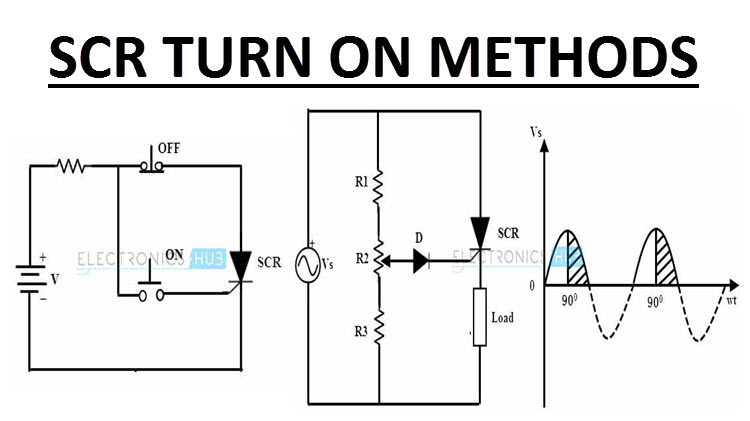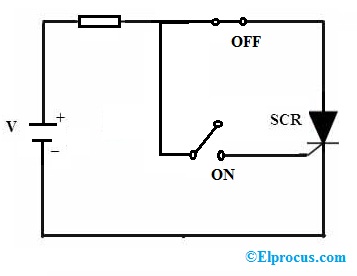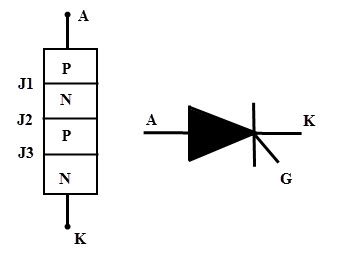Explain Different Triggering Methods of Scr
IHHolding current is the lowest current that flows through A. This commutation technique only occurs in AC circuit.

Thyristor Triggering Or Scr Triggering Electrical4u
Hence establishment of the emitter current gives rise α 2 as Presence of base current will generate collector current as.

. Triggering requirements are normally provided in terms of DC voltage and current. In other words the diode converts the AC current in to DC currentThis unique behavior of the diodes makes it possible to build different types of rectifiers such as half wave full wave and bridge rectifiers. Forward Blocking Mode of SCR.
Thyristor is turned on by increasing the anode current flowing through it. SCR Triggering Methods Forward Voltage Triggering Thermal or Temperature Triggering Radiation or Light triggering dvdt Triggering Gate Triggering. The increase in anode current can be achieved by many ways.
It says forward voltage triggering. A three-phase controlled rectifier circuit built with SCRs without pulse transformers or triggering circuitry shown would look like the Figure below. IGTmin Minimum gate triggering current is the minimum gate current that can trigger the SCR.
I B2 I g and emitter current of the T 2 transistor I E2 I k. A Natural Commutation When the anode current is reduced below the level of the holding current the SCR turns off. And no pulse is applied at the gate terminal.
SCR mode of operation. SCR working depends upon the battery polarity and the gate input. Voltage Thyristor Triggering- Here the applied forward voltage is gradually increased beyond a ptknown as forward break over voltage VBO and gate is kept open.
What is SCR Triggering. Turning ON of a thyristor refers to thyristor triggering. When a positive voltage is applied in.
In order to turn on the SCR the gate voltage V G is increased up to a minimum value to initiate triggeringThis minimum value of gate voltage at which SCR is turned ON is called gate triggering voltage V GTThe resulting gate current is called gate triggering current I GTThus to turn on an SCR all that we have to do is to. In the second half cycle another SCR connected in reverse direction to that of the other SCR gets triggered using another optoisolator and allows current to flow to the load. IFmax Maximum forward currentis maximum currents can flow in SCR without damage to the SCR.
Forward blocking mode OFF state Forward conducting mode ON state Reverse blocking mode. A Silicon-Controlled Rectifier or SCR is essentially a Shockley diode with an extra terminal added. Depending on the polarity of the voltage applied and the gate pulse given to the SCR it can operate in three different modes such as.
The SCR can operate in three different modes. Once turned on an SCR remains on as long as there is a minimum level of holding current flowing through the load circuit. In the first half cycle of the AC signal one of the SCR conducts after getting triggered using an optoisolator and allows the current to pass through the load.
This kind of triggering method is mainly used to increase the voltage among the anode and. If a light signal is given to the SCR junction then it produces ample energy to split the pairs of. SCR Turn ON Methods Light Triggering.
Natural Commutation of SCR. Electronics Hub - Latest Free Electronics Projects and Circuits. Three basic types of gate-firing signals are normally used.
This characteristics of SCR can be explained in four different modes. Natural Commutation and Forced Commutation. The resistor R E is chosen so that the load line determined by R E passes through the device characteristic in the negative resistance region that is to the right of the peak point.
At the first stage when we apply a gate current I g it acts as base current of T 2 transistor ie. The basic elements of such a triggering circuit are shown in figure. SCR Triggering Methods Forward Voltage Triggering Thermal or Temperature Triggering Radiation or Light triggering dvdt Triggering Gate Triggering.
We know that the diode allows electric current in one direction and blocks electric current in another direction. DC signals pulse signals and AC signals. The SCR triggering mainly depends on different variables such as temperature voltage supply.
Three-phase bridge SCR control of load. Types of SCR Commutation Techniques. There are three methods of switching off the SCR namely natural commutation reverse bias turn-off and gate turn-off.
SCR Turn On Methods Explained in Detail Forward Voltage Triggering. Natural Commutation of SCR is the process of turning off an SCR without using additional commutation circuitry. When anode of SCR connects to the positive and cathode of SCR with the negative of the battery terminal.
Carefully read the name of this method. Here is the explanation using two transistor model of SCR. Gate triggering most commonly used triggering technique for SCR.
There are mainly two types of SCR commutation techniques. Vi characteristics of SCR shown in the figure. Gate triggering is the method in which positive gate current.
To understand the SCR working principle we have to look into the different ways it can operate. The SCRs are constructed with three different types planar type Mesa type and Press pack type. Since pulse signals are ordinarily used for firing SCRs it is also necessary to.
SCR Triggering Methods An SCR normally can be triggered into conduction by applying a pulse of the control current to the gate. One common application of the uni junction transistor is the triggering of the other devices such as the SCR triac etc.

What Is Scr Triggering And Scr Turn On Methods

Scr Turn On Methods Scr Triggering Voltage Temperature Gate

Scr Turn On Methods Scr Triggering Voltage Temperature Gate

Radiation Or Light Triggering Of Scr Radiation Turn Ons Method
Comments
Post a Comment